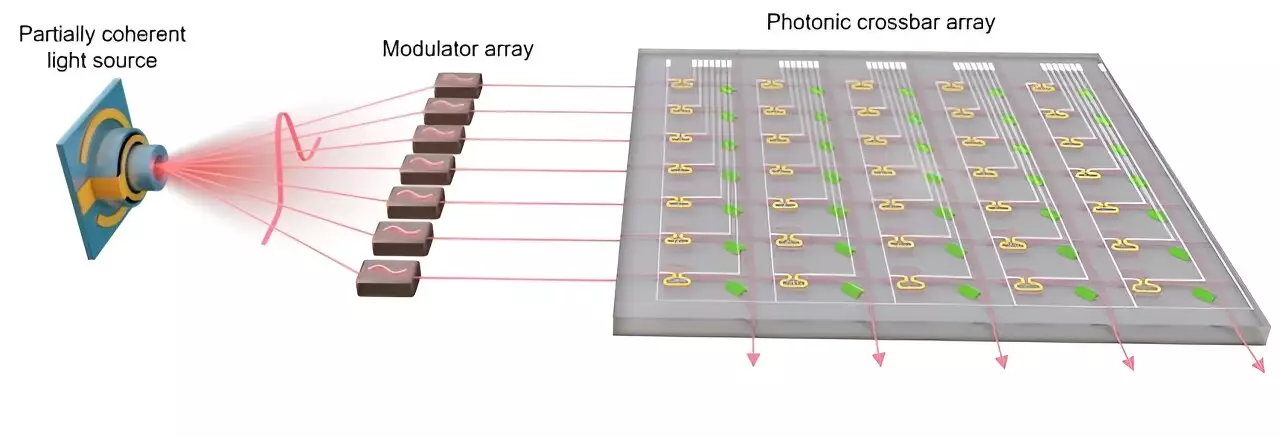Recent research published in *Nature* has sparked a seismic shift in our understanding of light sources crucial for photonic computing, particularly in the realm of artificial intelligence (AI) technologies. A collaborative team from the University of Oxford and other esteemed institutions like the Universities of Muenster, Heidelberg, and Ghent has unveiled a fascinating finding: less complex and cheaper light sources can outperform traditional high-coherence lasers in certain applications. This discovery does not merely challenge established norms; it redefines them, presenting a tangible pathway toward more accessible and energy-efficient technologies that could revolutionize AI computations.
Typically, high-coherence light sources like lasers have been the gold standard due to their precision in applications ranging from telecommunications to medical imaging. Their narrow wavelength ranges have long been associated with superior performance. Yet, the Oxford-led research team revealed that low-coherence light sources, akin to sunlight and regular bulbs, can surprisingly enhance performance in specialized cases. This counters the long-standing belief that higher coherence equates to higher performance in all contexts.
The Technical Marvel of Partially Coherent Light
At the heart of this breakthrough is the innovative use of a partially coherent light source derived from an electrically-pumped erbium-doped fiber amplifier. This device, typically utilized for amplifying light signals, was cleverly adapted. Instead of the traditional single coherent beam, researchers harnessed a narrow bandwidth of incoherent light, significantly amplifying the parallel computational capabilities of their system.
The implications are profound. By distributing this partially coherent light across multiple input channels in a parallel AI computational array, the researchers observed that performance improved dramatically—by a factor of N for an N-channel setup. This mechanism allows unprecedented speed, applying parallel processing capabilities that were previously thought achievable only with multiple coherent lasers.
In a compelling demonstration, this innovative method enabled an AI model to analyze patient gait and identify Parkinson’s disease with a remarkable classification accuracy exceeding 92%. Achieving accuracy on such a challenging task while leveraging a more accessible light source marks a significant leap in both machine learning and healthcare applications. Moreover, the ability to execute around 100 billion operations per second—equivalent to processing over two hours of 4K video in just one second—positions these low-coherence systems among the most sophisticated AI processors available.
Simplicity and Efficiency Redefined
The real beauty of this discovery lies not just in the technological prowess exhibited, but in the simplicity it introduces. Historically, high-spec systems utilizing coherent laser sources demanded intricate setups, significant financial investments, and high energy consumption. The adaptation of low-coherence light sources potentially mitigates these demands, paving the way for broader adoption in various sectors, particularly where cost and computational efficiency are paramount.
As highlighted by Dr. Bowei Dong, the first author of the study, utilizing lesser light sources can yield extraordinary results with scaling potential. The anticipated increase in computational speed—up to 100 times that of traditional laser systems—catapults these emerging technologies into a realm of efficiency and practicality hitherto unseen.
Future Perspectives in Optical Communications
While the immediate applications for this research showcase its prowess in AI-driven tasks, the potential for further exploration is expansive. Professor Harish Bhaskaran, the project’s lead, notes the exciting possibility that this understanding of partially coherent light may lead to advancements in optical communications. The implications for optical interconnect technology could usher in a new era of enhanced data transfer capabilities, lesser latency, and minimized resource consumption.
The reinforcement of our understanding of light’s behavior not only has the potential to democratize technology but also anticipates innovative applications across various fields. The journey of these researchers indicates an exciting future where simplicity and efficiency reign supreme in the sometimes overly complex domain of photonic computing.
With these findings, they are not just adding to the scientific discourse but potentially rewriting the rules of engagement in photonic technologies. This research is a testament to human ingenuity, reflecting that sometimes, looking into the less complex can yield the most profound advancements.

